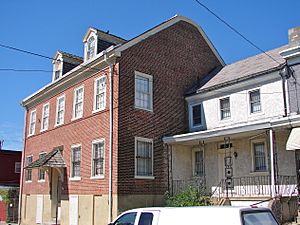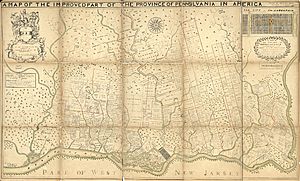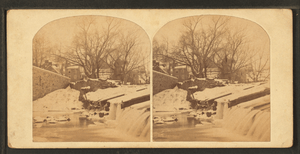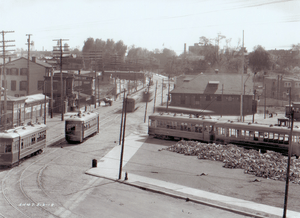Frankford, Philadelphia facts for kids
Quick facts for kids
Frankford
Neighborhood of Philadelphia |
|
|---|---|

John Ruan House
|
|
| Country | United States |
| State | Pennsylvania |
| County | Philadelphia |
| Time zone | UTC-5 (EST) |
| • Summer (DST) | UTC-4 (EDT) |
| Area codes | 215, 267, and 445 |
Frankford is a neighborhood in the Northeast part of Philadelphia. It's about six miles (10 km) northeast of Center City. Frankford's exact borders can be a bit unclear. Generally, it stretches from the Frankford Creek in the south to Cheltenham Avenue in the north. It also reaches Castor Avenue to the northwest and Aramingo Avenue and I-95 to the east. Nearby neighborhoods include Bridesburg, Juniata, Northwood, Summerdale, and Wissinoming.
In the past, Frankford was unofficially split into two parts: Frankford (the main area) and East Frankford. This division was mostly based on race, with African Americans living east of Frankford Avenue and Caucasians to the west. Today, the community is much more mixed, so this old division is not as important.

Contents
History of Frankford
Early Beginnings (1600s-1700s)
The village of Frankford was started by Quakers around 1682. This area was already home to people from Sweden and Germany.
Frankford became an official borough on March 2, 1800. Its first borders were Leiper Street, Little Tacony Creek, and Frankford Creek. Over time, the borough grew larger. In 1854, Frankford became part of the city of Philadelphia through a law called the Act of Consolidation, 1854.
Frankford was an important place for making things, starting with a gristmill built in the 1660s. This mill became famous during the American Revolutionary War. A brave woman named Lydia Darragh played a key role there.
Frankford also played a part in the Declaration of Independence. It was home to a gunpowder mill linked to Oswald Eve and Paul Revere.
Growth and Industry (1800s-1900s)
In the 1800s, Frankford became a center for making textiles, like cloth. Many other manufacturing businesses also grew here.
The Frankford Arsenal was a very important factory, especially during World War II. It was almost as big as the Philadelphia Navy Yard. At its busiest, the Frankford Arsenal employed over 22,000 people. It produced 8 million bullets every day!
In 1922, the Frankford Elevated Line opened. This train line connected Frankford to the Market Street Elevated, making it easy to get to Center City and West Philadelphia. Today, the end of the SEPTA Market-Frankford Line is called the Frankford Transportation Center. It's a major hub where people can connect to buses and trolleys that go all over Northeast Philadelphia. Many Frankford residents can walk to this station. The elevated train, or "El," runs through the neighborhood above Frankford Avenue.
Modern Frankford (Late 1900s-Today)
The Frankford Line helped Frankford Avenue become a big shopping area in the early 1900s. However, in the 1950s, the neighborhood started to decline. Many people moved from Philadelphia to the suburbs. This trend, called "white flight," continued through the 1970s and 1980s. By 1990, more than 30% of the shops on Frankford Avenue were empty.
Since then, Frankford has worked hard to improve. In 1993, the city created the Frankford Plan to help bring the neighborhood back to life. While some empty shops remain, new businesses have opened, serving new customers. Many business owners hope that the growth in nearby neighborhoods like Fishtown and Kensington will also help Frankford.
Places to Visit in Frankford
Museums and Historical Societies
- Grand Army of the Republic Museum and Library, located at 4278 Griscom St.
- Historical Society of Frankford, started in 1905, found at 1507 Orthodox St.
Churches and Places of Worship
Frankford is home to many different churches and places of worship, showing the diverse community. Some examples include:
- The Baptist Worship Center, 4355 Paul St.
- St. Bartholomew R.C. Church, 5600 Jackson St.
- By Grace Alone Christian Reformed Church, 1300 Dyre Street
- Campbell African Methodist Episcopal Church, 1657 Kinsey St., founded in 1804.
- Frankford Friends Meeting House, 4371 WALN ST., established in 1684.
- St. Joachim Church, Philadelphia, 1527 Church St., established in 1845.
- St. Mark's Church, Frankford, 4442 Frankford Ave., an Episcopal Church, established in 1832.
- The Presbyterian Church of Frankford, 4302 Frankford Ave., dating back to 1605.
Schools in Frankford
Frankford has several schools for students of all ages:
- The Charter School of Arts & Science: String Theory (formerly Henry R. Edmunds School), 1197 Haworth St.
- First Philadelphia Charter School for Literacy, 4300 Tacony St.
- Frankford Friends School, 1500 Orthodox St.
- Frankford High School, 5000 Oxford Ave.
- Warren G. Harding Middle School, 2000 Wakeling St.
- John Marshall School, Sellers and Griscom Sts.
Historic Landmarks
Frankford has many sites that are important to its history:
- Cedar Hill Cemetery, opened in 1849.
- Frankford Community Memorial Stadium, opened in 1922, where the Frankford Yellow Jackets professional football team played.
- Frankford Avenue, which was once called Main Street, and even earlier, the King's Highway.
Philadelphia Register of Historic Places
Several places in Frankford are listed on the Philadelphia Register of Historic Places, meaning they are protected for their historical importance:
- Campbell African Methodist Episcopal Church of Frankford, 1657 Kinsey St., founded around 1804. Its burial ground was also added to the Register in 2022.
- Comly Rich House (built 1826), 4276 Orchard Street, was the first house in the U.S. to get a mortgage (in 1831).
- The Free Burying Ground of Frankford (also known as Potter’s Field or Wilmot Cemetery), 1801 Meadow St. This site, now a playground, was approved as a public burying ground in 1811. It holds the remains of many African American Civil War Veterans.
- Greenwood Cemetery, established in 1869.
National Register of Historic Places
Some Frankford sites are also on the National Register of Historic Places, recognizing their importance to the entire country:
- Frankford Arsenal
- Friends Hospital, the first private psychiatric hospital in the U.S., founded in 1813.
- The John Ruan House, built in 1796.
Other Important Places
- Frankford Hospital
- Eastern Regional Medical Center, a facility of Cancer Treatment Centers of America.
Northwood: A Neighborhood Within Frankford
Northwood is a special area inside Frankford. It is mostly made up of homes built before World War II. Northwood is generally bordered by Harrison Street to the south, Roosevelt Boulevard to the west, Oxford Avenue to the east, and Sanger Street to the north.
Three of Frankford's schools are located in Northwood. Other important places include Frankford High School's War Memorial Stadium, built to honor local residents who served in World War I. There's also Baldwin Field, named after E. A. Baldwin, a local businessman.
Northwood is home to many middle-class families. Famous people who lived here include former Philadelphia mayor William J. Green, III and the late Edward R. Becker, a judge for the United States Court of Appeals.
Northwood Civic Association
The Northwood Civic Association is a group that works to improve the community. It was officially started on July 25, 1963.
The main goals of the Association are:
- To help the community's civic, social, and moral well-being.
- To keep the neighborhood pleasant and protest land uses that might lower property values.
The Association's community boundaries are clearly defined. They run along the East side of Roosevelt Boulevard from Friends Hospital to Castor Avenue and Sanger Street, then along Sanger Street to Oxford Avenue, and so on.
People of Frankford
Frankford is a very diverse neighborhood. Many different ethnic groups live here, including Irish Americans, Polish Americans, Italian Americans, Portuguese Americans, Brazilian Americans, Arab Americans, African Americans, and Hispanic Americans (especially from Puerto Rico and the Dominican Republic). There are also many West Indian Americans from places like Trinidad and Tobago, Jamaica, and Haiti.
Based on the 2010 census, the population of Frankford was about 31.8% African American, 30.8% White, 29% Hispanic, and 8.4% other groups. The population of Frankford grew by 3% between 1990 and 2000.
Notable People from Frankford
Many interesting people have connections to Frankford:
- Butch Ballard, a famous jazz drummer and band leader.
- Edward R. Becker, a judge for the United States Court of Appeals for the Third Circuit.
- Stephen Decatur Sr., who lived here for a time.
- Dr. Enoch Edwards, a surgeon who had a summer home in Frankford. He studied under Dr. Benjamin Rush.
- Earl G. Harrison, who was the Dean of the University of Pennsylvania Law School.
- William Walker Foulkrod, a U.S. Congressman.
- Dr. Benjamin Rush, a Continental Congressman and a signer of the American Declaration of Independence, also had a summer home here.
Education in Frankford
The School District of Philadelphia serves Frankford. Frankford High School has been the public high school for the community since 1910. Besides public schools, there is also Frankford Friends School, a private school for Pre-Kindergarten through 8th grade.
The Free Library of Philadelphia has a branch in Frankford called the Frankford Branch. The Frankford Hospital School of Nursing also operated here from 1904 to 2020.
Sports in Frankford
Frankford was once home to the Frankford Yellow Jackets, a professional National Football League team. They even won the championship in 1926! The team stopped playing in 1931.
Frankford is also home to the N.E. Frankford Boys and Girls Club American Legion Post 224 Drill Team. This team won the AMA Nationals Championship in both 2005 and 2006. For many decades, the Frankford Boys Club was a big part of the community. It gave young people in Frankford the chance to learn and play football, baseball, softball, basketball, and cheerleading. The Boys Club was very successful, winning many championships in the 1990s and 2000s.
Images for kids
-
A map of Philadelphia County, Pennsylvania showing Frankford Borough prior to and after the Act of Consolidation, 1854









